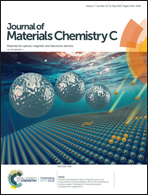Improving the electroluminescence performance of blue light-emitting poly(fluorene-co-dibenzothiophene-S,S-dioxide) by tuning the intra-molecular charge transfer effects and temperature-induced orientation of the emissive layer structure†
Abstract
We designed and synthesized a series of charge-carrier-balanced blue light-emitting poly(fluorene-co-dibenzothiophene-S,S-dioxide) (PFSO10) derivatives (PFTAsSO10 and PFSO10TAs) by incorporating an electron-rich triphenylamine (TA) unit into the polymer. To effectively weaken the intramolecular charge transfer (ICT) effects in the electron-deficient dibenzothiophene-S,S-dioxide (SO) and electron-rich TA units in the polymer main chain, the copolymers PFSO10TAs end-capped by the TA unit were synthesized by one-pot Suzuki polymerization. Atomic force microscopy and grazing incidence X-ray diffraction measurements revealed a rougher morphology associated with an effectively enhanced ordering of polymer chains across the entire PFSO10TAs polymer film processed by thermal annealing at 115 °C for 10 min. The introduction of the TA unit into PFSO10 significantly improved the electroluminescence (EL) performance of the blue-emitting polymers. The device also showed stable EL spectra at varying current densities from 100 mA cm−2 to 800 mA cm−2 and thermal annealing temperatures from 40 °C to 180 °C. The EL performance of a single-layer device based on PFSO10TA2 thermally annealed at 80 °C outperforms those of the devices fabricated from the PFSO10 and PFTAsSO10 copolymers. In particular, the EL performance of PFSO10TA2 was dramatically enhanced by thermal annealing at 115 °C for 10 min, resulting in a maximum luminous efficiency of 7.30 cd A−1 with Commission Internationale de L’Éclairage coordinates of (0.16, 0.15) and a very slow efficiency roll-off. The enhanced efficiency could be attributable to the relatively weak ICT effect, improved electron and hole transport balance and more ordered stacking of polymer chains in the thin film. These results demonstrate that tuning the ICT effect and temperature-induced orientation could be a promising strategy for achieving high-efficiency blue-light-emitting copolymers in single-layer devices.



 Please wait while we load your content...
Please wait while we load your content...